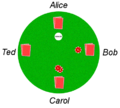Texas hold 'em facts for kids
Texas hold'em is a very popular version of the card game poker. It's a game where players try to make the best five-card hand using their own cards and shared cards on the table.
Contents
How to Play Texas Hold'em
Before the game starts, two players sitting to the left of the dealer must place special bets. These are called the "Small Blind" and the "Big Blind." The Big Blind is usually twice as much as the Small Blind. For example, if the Big Blind is $10, the Small Blind would be $5. This money goes into the "pot," which is the central pile of money on the table that players are trying to win.
Each player then receives two cards face down. These are your "Hole Cards," and only you can see them. After everyone has their Hole Cards, the first round of betting begins. The player to the left of the Big Blind starts this round.
Players have a few choices:
- Call: Match the current bet amount.
- Raise: Bet more than the current bet. This makes other players have to pay more to stay in the game.
- Fold: Give up your hand and any money you've already bet. You can't win the pot in this round.
This betting continues around the table until everyone has either called the highest bet or folded.
The Flop
After the first betting round, the dealer places three cards face up in the middle of the table. This is called the "Flop." These are "community cards," meaning all players can use them with their two Hole Cards to make the best possible poker hand. Another round of betting then takes place. In this round, if no one has bet yet, players can "Check," which means they don't bet any money but stay in the hand.
The Turn
Next, the dealer places a fourth community card face up. This card is called "the Turn." After the Turn, there's another round of betting, similar to the one after the Flop.
The River
Finally, the dealer places the fifth and last community card face up. This is called "the River." One more round of betting happens after this card is dealt.
Winning the Game
After all five community cards are out and the final betting round is over, players show their cards. Each player uses their two Hole Cards and the five community cards to make the best possible five-card poker hand. The player with the best hand wins all the money in the pot! If two or more players have the exact same best hand, they split the pot equally.
Sometimes, a player might bet, and everyone else folds their hand. If this happens, the player who made the bet wins the pot right away, and they don't even have to show their cards.
Different Ways to Play
Texas Hold'em can be played with different rules about how much players can bet or raise. These are called "styles of play."
Limit Games
In "Limit" games, there's a set amount you can bet or raise. For example, if the limit is $10, every bet or raise must be exactly $10. There's often a "cap" on how many times players can raise in one betting round, usually three times. Also, in Limit games, the bet amount often doubles for the betting rounds after the Turn and River cards are dealt.
Example of Limit Play
Imagine four players. Player A bets $10.
- Player B wants to raise, so they bet $20 ($10 to call Player A, plus $10 more for the raise).
- Player C wants to stay in, so they "call" Player B by betting $20.
- Now, Player D can either fold, call Player B by betting $20, or raise another $10, making the total bet $30.
- Player A would then have to decide if they want to call the new bet or fold. This continues until all players have called the highest bet or folded.
Pot Limit Games
In "Pot Limit" games, the most a player can bet or raise is the total amount of money currently in the pot. As players bet, the pot gets bigger, so the possible raises can also get much larger.
No Limit Games
"No Limit" is a very exciting way to play because there's no maximum limit on how much you can bet at any time. A player can bet all of their money if they want to! When a player bets all their money, it's called going "All In."
If you go All In and another player has less money than you bet, they can still call your bet by going All In with all their chips. If you win the hand, you only get back the amount that the other player had. Any extra money you bet beyond that amount is returned to you.
Tournaments
Many people see poker tournaments on television. In a tournament, players pay an "entry fee" called a "buy-in." Most of this money goes into a big "prize pool." Players get a certain number of chips, which don't have real cash value but are used to play the game.
The goal in a tournament is to win all the chips from other players. When a player runs out of chips, they are "busted out" of the tournament. The tournament continues until only one player has all the chips. That player is the winner! The prize pool is usually divided among the top players, with the first-place winner getting the biggest share.
Tournament blinds usually increase over time. This makes the game move faster as players get more chips. Most tournaments are "freeze out" tournaments, meaning you can only buy chips once at the beginning. Some allow players to "re-buy" more chips during the first few rounds.
Images for kids
fa:تگزاس هولد ام
See also
 In Spanish: Texas hold 'em para niños
In Spanish: Texas hold 'em para niños




